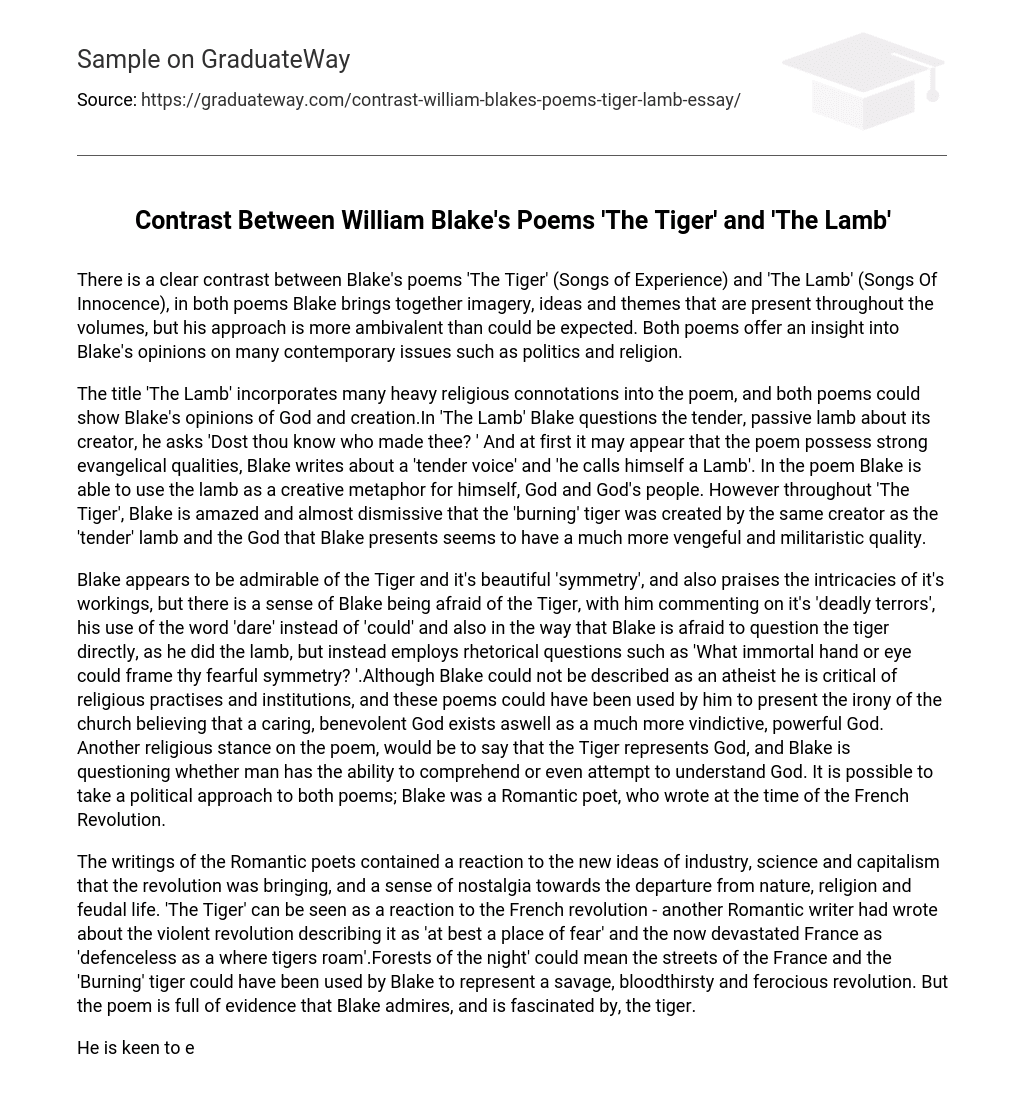Blake’s poems, ‘The Tiger’ from Songs of Experience and ‘The Lamb’ from Songs of Innocence, reveal a noticeable contrast. Although both poems incorporate recurring imagery, ideas, and themes found throughout the volumes, Blake’s viewpoint is more complex than one might anticipate. These poems also provide a glimpse into Blake’s thoughts on various contemporary topics including politics and religion.
The poem titled ‘The Lamb’ incorporates numerous religious connotations, implying Blake’s opinions on God and creation. In this poem, Blake questions the gentle and passive lamb about its creator with the line “Dost thou know who made thee?” At first glance, the poem appears to possess strong evangelical qualities as Blake writes about a “tender voice” and how the creator calls himself a lamb. Within the poem, Blake metaphorically uses the lamb to represent himself, God, and God’s people. However, in ‘The Tiger’, Blake is astonished and somewhat dismissive that the same creator who made the gentle lamb also created the “burning” tiger. The God portrayed by Blake in this poem seems to have a more vengeful and militaristic nature.
Blake seems to admire the Tiger and its exquisite “symmetry,” and also commends the intricacies of its workings. However, there is a sense of fear in Blake, as he mentions the Tiger’s “deadly terrors,” his use of “dare” instead of “could,” and his reluctance to directly question the Tiger, like he did with the lamb. Instead, he poses rhetorical questions such as “What immortal hand or eye could frame thy fearful symmetry?” Although Blake cannot be labeled as an atheist, he criticizes religious practices and institutions. These poems may serve as a way for him to highlight the irony of the church’s belief in a caring, benevolent God alongside a much more vindictive, powerful God. Another religious interpretation of the poem could be that the Tiger represents God, and Blake questions whether humans have the capacity to comprehend or even attempt to understand God. One can also approach these poems from a political perspective, considering that Blake was a Romantic poet who wrote during the French Revolution.
The Romantic poets’ writings displayed a response to the revolution’s novel concepts of industry, science, and capitalism, as well as a nostalgic longing for the loss of nature, religion, and feudal life. ‘The Tiger’ can be interpreted as a reaction to the French revolution. One Romantic writer previously depicted this violent revolution as ‘at best a place of fear’ and likened France, now devastated, to a ‘defenceless land where tigers roam’. The phrase ‘Forests of the night’ could symbolize the streets of France, while the ‘Burning’ tiger may serve as Blake’s representation of a savage, bloodthirsty, and ferocious revolution. Nevertheless, the poem provides plentiful evidence of Blake’s admiration for and fascination with the tiger.
In this text, the author discusses Blake’s portrayal of the revolutionary French people as a symbol of unity and symmetry. The author suggests that Blake’s portrayal of the Lamb as a passive and easily shepherded society can be contrasted with the assertiveness and challenge depicted in the Tiger. While Blake admires the Tiger’s power, he also acknowledges its uncontrollable nature. This portrayal of the Tiger could potentially critique the revolutionary thinkers’ change in perspective on nature.
The poem ‘The Tiger’ by Blake challenges the belief of some revolutionary thinkers who saw nature as a tamed and rational force. Blake presents nature as wild and powerful, contrasting it with the lamb. This may be Blake’s way of questioning whether one can truly understand such a force. The poem has a fast and pounding rhythm, possibly representing the creator’s actions or the pounding of the heart. In contrast, ‘The Lamb’ has a softer and more docile tone, with repeated questions.The poem ‘The Tiger’ has a more calm and patient tone compared to ‘The Lamb’, with a slower rhyme scheme that includes words like ‘delight’ and ‘bright’. The hurried structure of ‘The Tiger’ aligns with the political stance of the poem, reflecting the rapid spread of revolutionary and often subversive ideas. Blake’s response in both poems makes it difficult to categorize them strictly as either ‘Innocence’ or ‘Experience’. Ultimately, despite their seemingly modest intellectual nature and simple descriptions, Blake successfully presents his views on religion and politics in a way that is understandable to the reader.





